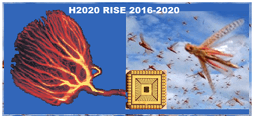Hongzhuo Liang is a fifth-year PhD student in Computer Science at Universität Hamburg. His research interests are robotic grasping manipulation based on multimodel perception. Hongzhuo has been working on the project Transregio SFB “Cross-modal learning” for STEP2DYNA and ULTRACEPT (778062) Work Package 4.
The IEEE/RSJ International Conference on Intelligent Robots and Systems (IROS) is one of the largest and most impacting robotics research conferences worldwide. Established in 1988 and held annually, IROS provides an international forum for the international robotics research community to explore the frontier of science and technology in intelligent robots and smart machines.
Researcher Hongzhuo Liang from STEP2DYNA partner the Universität of Hamburg attended and presented at IROS 2020. In addition to technical sessions and multi-media presentations, the IROS conference also held panel discussions, forums, workshops, tutorials, exhibits, and technical tours to enrich the fruitful discussions among conference attendees.
Due to COVID-19, the conference was hosted online with free access to every Technical Talk, Plenary, and Keynote and over sixty Workshops, Tutorials and Competitions. This went online on 24th October 2020 and was available until 24th January 2021.
Robust Robotic Pouring using Audition and Haptics

At IROS 2020, Hongzhuo Liang presented his conference paper:
H. Liang et al., “Robust Robotic Pouring using Audition and Haptics,” 2020 IEEE/RSJ International Conference on Intelligent Robots and Systems (IROS), Las Vegas, NV, USA, 2020, pp. 10880-10887, doi: 10.1109/IROS45743.2020.9340859.
Video footage of Hongzhuo’s work can be viewed on the UHAM Technical Aspects of Multimodal Systems (TAMS) YouTube channel.
Abstract
Robust and accurate estimation of liquid height lies as an essential part of pouring tasks for service robots. However, vision-based methods often fail in occluded conditions, while audio-based methods cannot work well in a noisy environment. We instead propose a multimodal pouring network (MP-Net) that is able to robustly predict liquid height by conditioning on both audition and haptics input. MP-Net is trained on a self-collected multimodal pouring dataset. This dataset contains 300 robot pouring recordings with audio and force/torque measurements for three types of target containers. We also augment the audio data by inserting robot noise. We evaluated MP-Net on our collected dataset and a wide variety of robot experiments. Both network training results and robot experiments demonstrate that MP-Net is robust against noise and changes to the task and environment. Moreover, we further combine the predicted height and force data to estimate the shape of the target container.
Further information about this paper, including links to the code can be found here.
